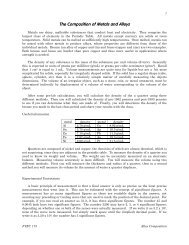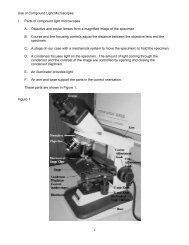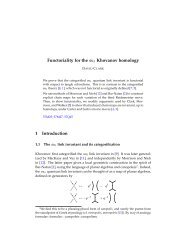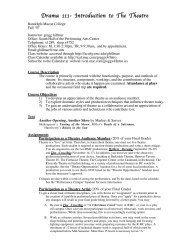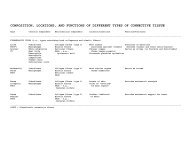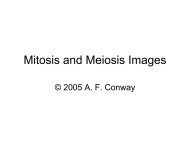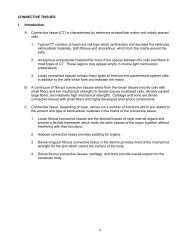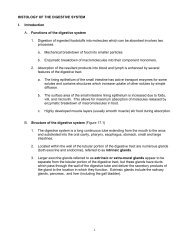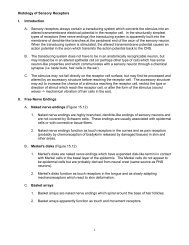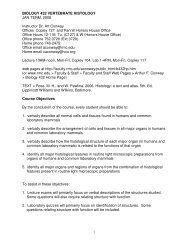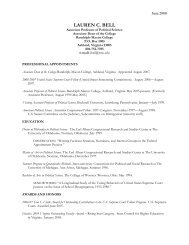Histology of the Human Ear I. External ear (Figure ... - Faculty.rmc.edu
Histology of the Human Ear I. External ear (Figure ... - Faculty.rmc.edu
Histology of the Human Ear I. External ear (Figure ... - Faculty.rmc.edu
Create successful ePaper yourself
Turn your PDF publications into a flip-book with our unique Google optimized e-Paper software.
(2) Function<br />
(a) When <strong>the</strong> organism's head moves, <strong>the</strong> fluid in <strong>the</strong> semicircular canal tends<br />
to stay in place due to inertia.<br />
(b) The head movement <strong>the</strong>refore results in <strong>the</strong> wall <strong>of</strong> <strong>the</strong> canal moving past<br />
<strong>the</strong> fluid.<br />
(c) Movement <strong>of</strong> <strong>the</strong> wall relative to <strong>the</strong> fluid causes <strong>the</strong> fluid to press on <strong>the</strong><br />
"dam" in <strong>the</strong> ampulla (<strong>the</strong> cupula) formed by <strong>the</strong> gelatinous mass attached<br />
to <strong>the</strong> hair cells.<br />
(d) Bending <strong>of</strong> <strong>the</strong> cupula in turn moves <strong>the</strong> processes <strong>of</strong> <strong>the</strong> hair cells.<br />
(e) Movement <strong>of</strong> <strong>the</strong> processes on <strong>the</strong> hair cells changes <strong>the</strong> frequency <strong>of</strong><br />
impulses in <strong>the</strong> sensory neurons which receive inputs from <strong>the</strong> hair cells.<br />
(f) The organism experiences stimulation <strong>of</strong> <strong>the</strong> ampullae as motion, but <strong>the</strong><br />
stimulus is actually acceleration (a change in <strong>the</strong> rate <strong>of</strong> motion).<br />
c. Cochlea (<strong>Figure</strong> 25.1, 25.4, 25.13, 25.14, 25.17, 25.21, Plate 104, Plate 105)<br />
(1) Structure<br />
(a) The cochlea is a tubular structure which is coiled into a snail shell-like<br />
spiral.<br />
(b) Two outer canals run <strong>the</strong> full length <strong>of</strong> <strong>the</strong> cochlea.<br />
- <strong>the</strong> vestibular canal (scala vestibuli)<br />
- <strong>the</strong> tympanic canal (scala tympani)<br />
(c) The outer canals are continuous at <strong>the</strong> tip <strong>of</strong> <strong>the</strong> cochlea.<br />
(d) A central canal (<strong>the</strong> cochl<strong>ear</strong> duct) is located between <strong>the</strong> two outer<br />
canals and does not connect directly to <strong>the</strong> two outer canals.<br />
(e) The sensory cells (hair cells) are embedded in <strong>the</strong> columnar epi<strong>the</strong>lium that<br />
forms <strong>the</strong> "floor" <strong>of</strong> <strong>the</strong> cochl<strong>ear</strong> duct. The complex <strong>of</strong> hair cells and<br />
supporting cells is called <strong>the</strong> Organ <strong>of</strong> Corti.<br />
(f) Two arrays <strong>of</strong> hair cells (inner and outer) run longitudinally within <strong>the</strong> organ<br />
<strong>of</strong> Corti.<br />
(g) The microvilli <strong>of</strong> <strong>the</strong> hair cells are embedded in a gelatinous structure (<strong>the</strong><br />
tectorial membrane) which runs longitudinally in <strong>the</strong> organ <strong>of</strong> Corti.<br />
(h) One edge <strong>of</strong> <strong>the</strong> organ <strong>of</strong> Corti (both tectorial membrane and sensory<br />
epi<strong>the</strong>lium) is anchored to bone (<strong>the</strong> osseus spiral lamina). The o<strong>the</strong>r edge<br />
is much more flexible.<br />
5



